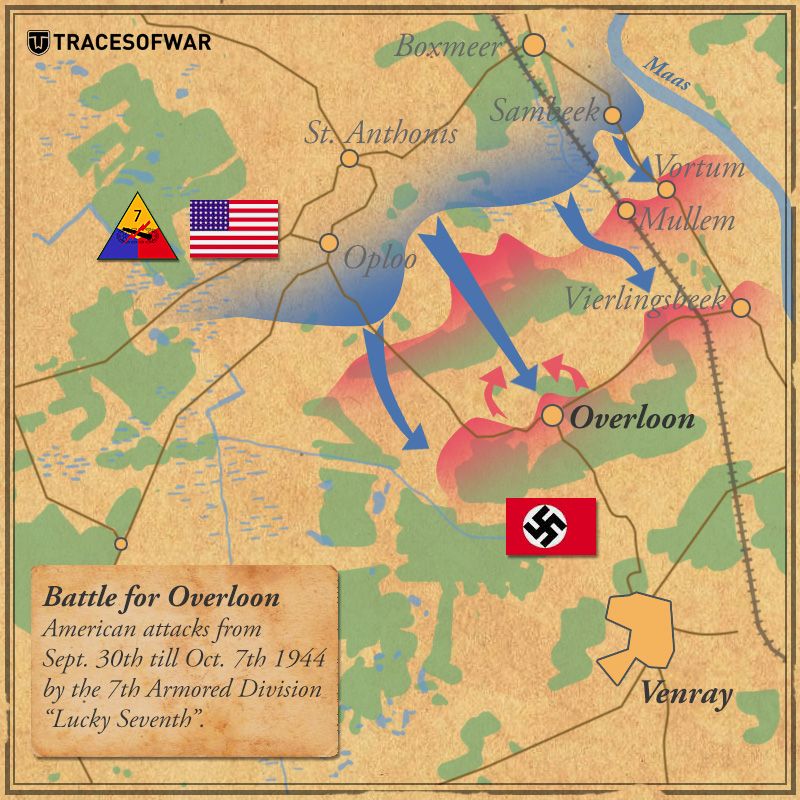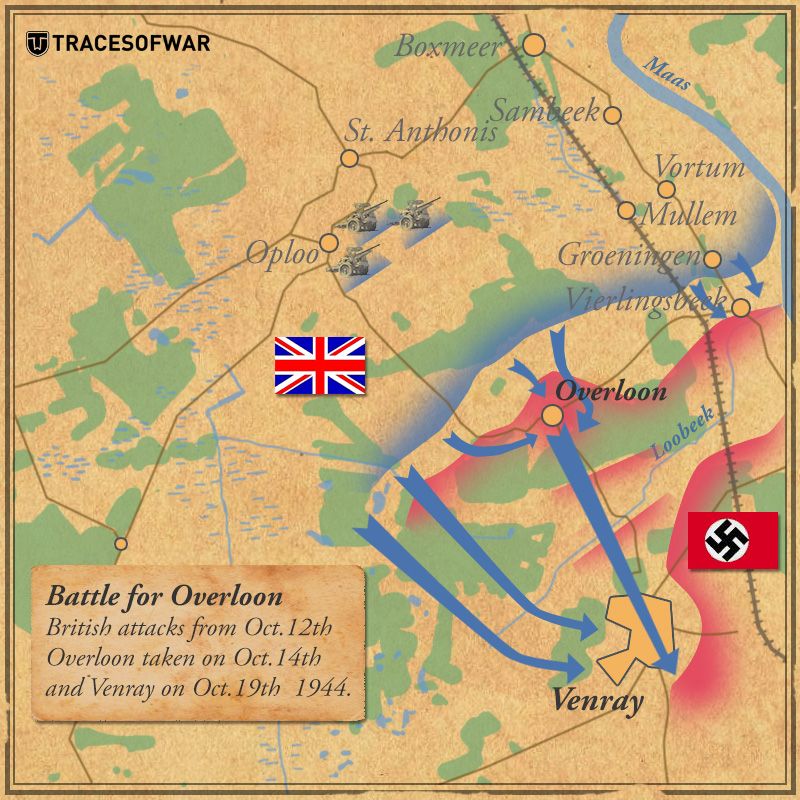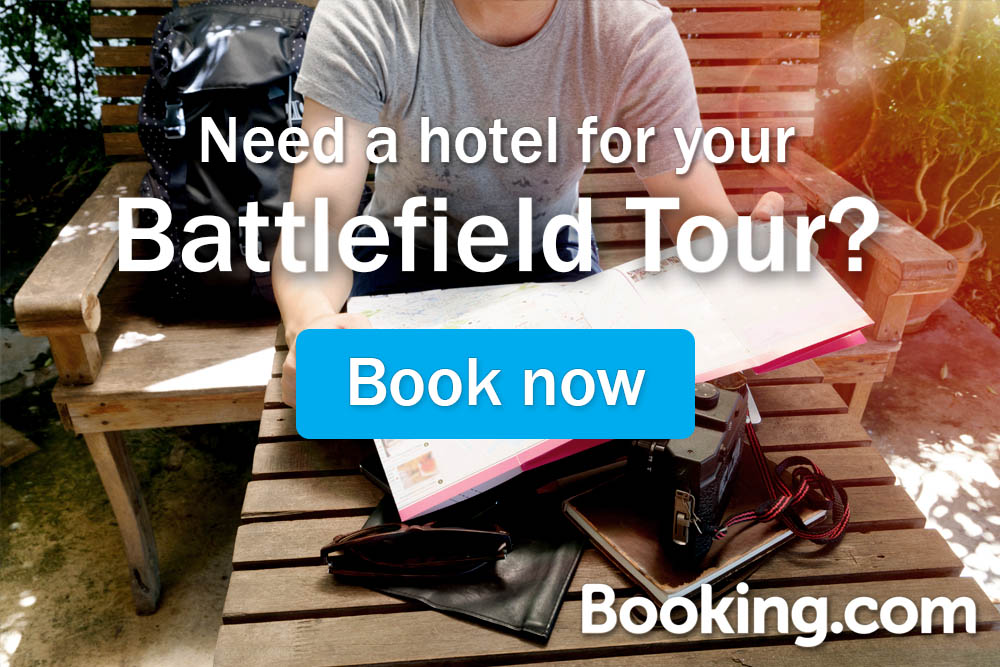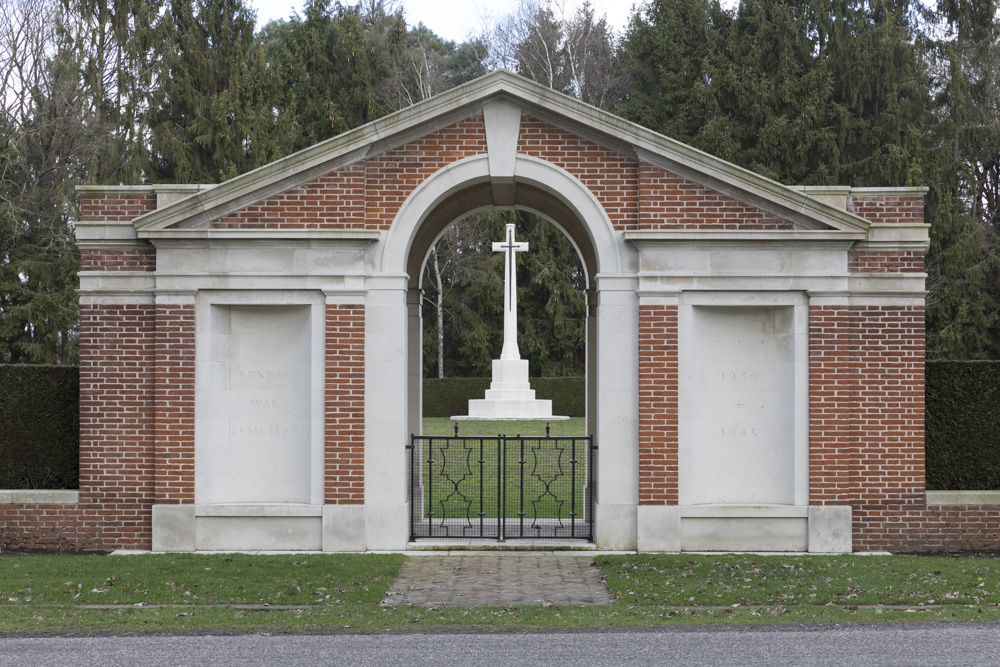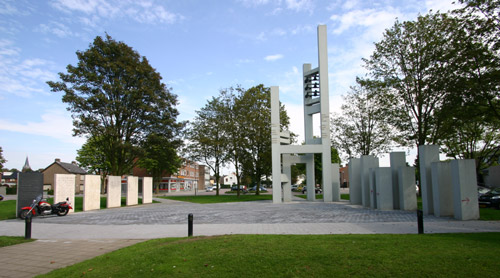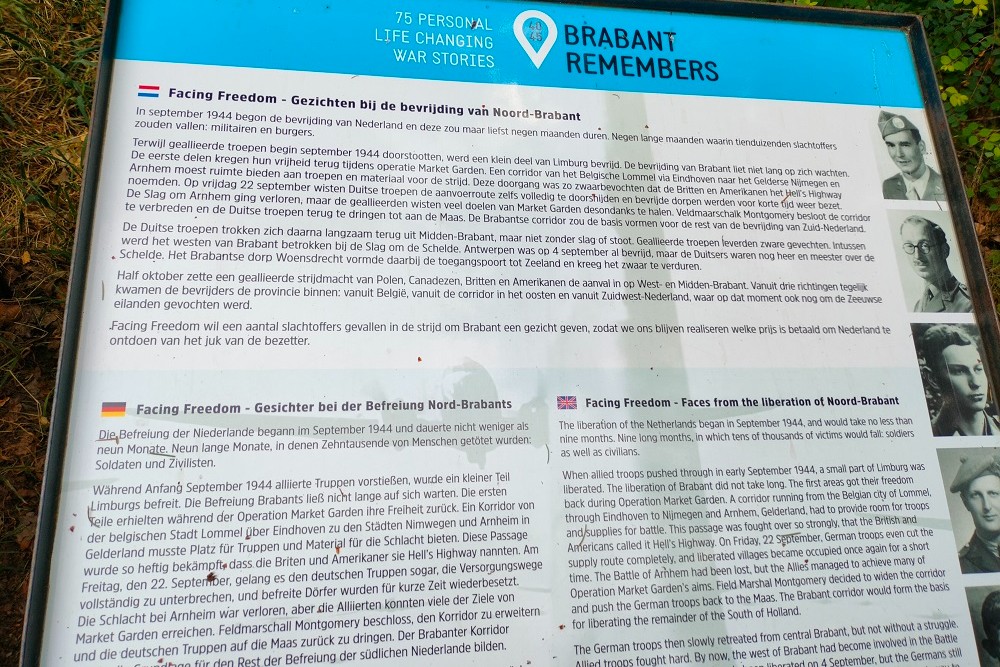Introduction
"Overloon, it’s mines, mud and woods, stiff with the enemy all the way!"
"The concussion had blown me to the floor of the turret of our Churchill tank. I could only see an inferno of burning and smoke. The noise of the shell penetration was horrendous. It was just as though a large giant had torn steel in two. It was a tearing sound that is unforgettable. " (C.P. Lamb, Grenadier Guards)
Introduction
In the autumn of 1944, in a remote area of the Netherlands known as de Peel, a vicious battle was fought to reduce a German bridgehead west of the Meuse near the German border. Preceded by Market-Garden and followed by the Ardennes offensive and because of its dismal nature, heavy losses and lack of success it has been somewhat forgotten in history. Hence "forgotten battle" or "battle in the shadow". The troops themselves called it "Second Caen", because of the ferocity and unforgiving nature of the fighting. The operation was conducted by the US 7th Armored Division and later British 3rd Infantry and 11th Armoured Divisions. On the defending side was the German Kampfgruppe Walther consisting of paratroopers from the 21. Regiment, a battalion sized unit from the 10. SS-Panzerdivision Frundsberg and a Luftwaffe 88 mm battalion. The hard core of the unit was the 107. Panzerbrigade.
Between September,30th and October 14th, 1944 a bloody battle raged around the village of Overloon. In circumstances reminiscent of the Great War the British plodded further across the heavily mined Loobeek which they finally took on October, 16th. Venray fell on October, 19th, 1944. Then the offensive was suspended. The troops were needed elsewhere for the fighting around the Scheldt estuary in order to open a route to Antwerp. This harbour was needed urgently if the allied supply situation was to be solved. Only on December, 3rd, 1944, the German bridgehead was finally eliminated with the capture of Blerick, a suburb of Venlo on the west bank of the Meuse. Venlo itself would remain in German hands until March, 1945, in the battle for the Roer triangle.
What preceded the battles
During the partial failure of operation Market-Garden an allied salient of 80 km deep and 20-30 km wide was formed that stretched from the Belgian-Dutch border up till north of Nijmegen. Already during the fighting in and around Arnhem the corridor’s only supply road, Hell’s highway, was cut several times. This was one, among various reasons, why British XXX Corps didn’t advance quick enough. The paratroopers at Arnhem couldn’t be reached in time and were defeated. The front stabilized around Nijmegen beyond the river Waal.
Field Marshal Bernard Montgomery, with typical British optimism, found that "Market-Garden had been a 90 % success". He wanted to try an alternative river crossing into Germany and its vital industrial Ruhrgebiet. Instead of crossing the Lower Rhine and river Ijssel beyond Arnhem he now envisaged an attack through Gennep, Kleve and Emmerich in order to capture Düsseldorf and Cologne. By crossing the Meuse and the Rhine the strongest part of the Siegfried Line defences would be bypassed . In order for this to succeed the German bridgehead in the bend of the Meuse between Boxmeer and Wessem needed to be taken out.
The allies still underestimated the military strength of Germany at that moment. This would also appear during the fighting around Aachen ( 2nd – 21st of October,1944) and the Hürtgenwald (October 6th-December 1st, 1944) and by the surprise that the German offensive in the Ardennes would achieve ( December 16th , 1944 onwards). By and large the allies thought that Germany was about to collapse soon.
Generalfeldmarschall Walter Model had his own plans with the Brückenkopf Venlo. Eventually he planned to launch an offensive towards Nijmegen. The bridgehead was reinforced, unnoticed by allied intelligence. When the allies attacked on September, 30th, 1944 there were 15,000 German soldiers in the area. Allied intelligence had estimated 2,000 mostly badly trained and demoralized troops. German LXXXVI Corps had the 7. Fallschirmjägerdivision "Erdmann" and the weak 180. Infantry Division. The strongest unit in the vicinity of Overloon where the American 7th Armored was about to attack was the 107. Panzerbrigade. Originally intended for the Eastern Front the armoured brigade was transported to Venlo during Market-Garden. It had already given the allies some surprises near Helmond.The front ran west of Overloon at Oploo, to the north of Overloon in forested areas and over the railway towards the twin villages of Vortem-Mullem near the Meuse. The Hauptkampflinie, HKL or the front, was held by three parachute batallions of 21.para regiment , Luftwaffen-Festungs-Bataillon X near the hamlet of the Hattert and a unit from battalion size from the SS-Panzerdivision Frundsberg under command of Sturmbannführer Franz Roestl with as its major fire power 15 StuGs assault guns.
Definitielijst
- Ardennes offensive
- Battle of the Bulge, “Von Rundstedt offensive“ or “die Wacht am Rhein“. Final large German offensive in the west from December 1944 through January 1945.
- brigade
- Consisted mostly of two or more regiments. Could operate independently or as part of a division. Sometimes they were part of a corps instead of a division. In theory a brigade consisted of 5,000 to 7,000 men.
- Infantry
- Foot soldiers of a given army.
- Kampfgruppe
- Temporary military formation in the German army, composed of various units such as armoured division, infantry, artillery, anti-tank units and sometimes engineers, with a special assignment on the battlefield. These Kampfgruppen were usually named after the commander.
- Luftwaffe
- German air force.
- Marshal
- Highest military rank, Army commander.
- offensive
- Attack on a smaller or larger scale.
- paratroopers
- Airborne Division. Military specialized in parachute landings.
- Regiment
- Part of a division. A division divided into a number of regiments. In the army traditionally the name of the major organised unit of one type of weapon.
Images
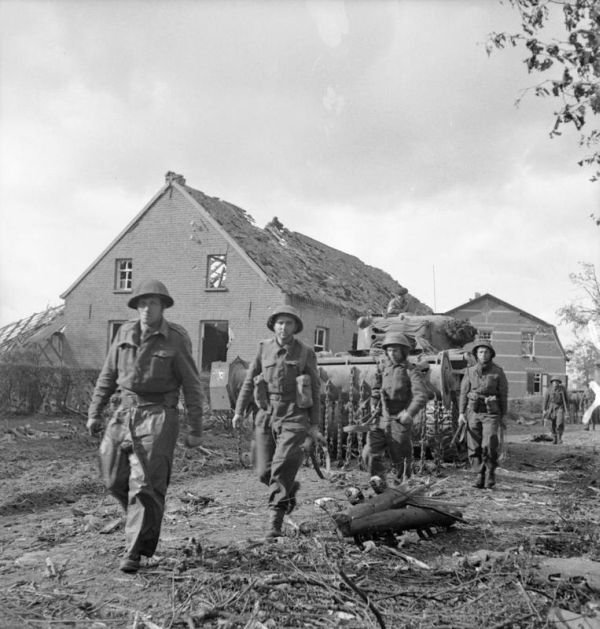 A Sherman 'crab' or 'flail' mine clearing tank and Royal Engineers at Overloon, October, 14th,1944. Source: Imperial War Museum.
A Sherman 'crab' or 'flail' mine clearing tank and Royal Engineers at Overloon, October, 14th,1944. Source: Imperial War Museum. Field Marshall Montgomery studying a map with Lieutenant-General Horrocks (commanding officer of XXX Corps) and Prince Bernard during operation Market-Garden, September,1944. Source: Imperial War Museum.
Field Marshall Montgomery studying a map with Lieutenant-General Horrocks (commanding officer of XXX Corps) and Prince Bernard during operation Market-Garden, September,1944. Source: Imperial War Museum. Generalfeldmarshall Model during a visit to Aachen, October, 9th,1944. Source: Bundesarchiv.
Generalfeldmarshall Model during a visit to Aachen, October, 9th,1944. Source: Bundesarchiv.30 September - 7 October 1944
The American plan.
The first attack towards Overloon was assigned to the US 7th Armored Division. The nickname was "Lucky seventh". The name came from a speech by then CO major-general Alvin C. Gillem jr. According to him the division was lucky in that it trained together with the 3rd Armored Division and that it had him as commander.
The 7th landed in Normandy, France on August 13th and 14th and participated in the chase of the defeated German army. It was fairly successful in doing that. The soldiers called themselves the Ghost Division for their tendency to appear where the Germans didn’t expect them. Ironically another 7th armoured division had had the same nickname, Gespenstdivision, led by Erwin Rommel in May and June of 1940. Joseph Goebbels wrote in his diary on September, 2nd, 1944: "The Americans show us (vorexerzieren) how to conduct a Blitzkrieg in much the same manner that we showed the French and the British in 1940."
The division was transferred to de Peel in a two day march from Metz where it had encountered its first serious resistance when crossing the Moselle. Because intelligence assumed that German forces in the area were weak and badly trained or motivated the CO didn’t think it necessary to reconnoitre himself. The attack was to be straightforward, along five axes of attack.
Next to faulty intelligence there was a number of reasons why the Americans didn’t take Venlo in one or two days, as was the objective when they attacked. German intelligence was aware of the recent movements. The Germans had well prepared their defences. Metalled roads were very few in this part of the Netherlands. Another problem was the weather. The heavy rains hindered effective air support and contributed to the difficult terrain. German anti- tank guns and artillery were well placed and camouflaged. There were vast stretches of woods in the area both to the north as well as to the south of Overloon, concealing the strength of German defences from aerial observation.
The Americans attack
The population in the soon to be war zone had been evacuated by orders of the Germans. On Saturday, September 30th, 1944, the Americans attacked. The objective of the day was Venlo. This was exemplary of the US optimism; Blerick, the suburb of Venlo on the west bank of the Meuse would be taken only on December,15th of 1944. Venlo would eventually be liberated only on the 1st of March,1945.The weather was dismal during the attack so that the air force couldn’t assist. Combat commands A and B soon bogged down in the face of the German defences and their fire power. Mine fields also took their toll. The American armour and armoured infantry came under fire from well positioned machine guns, mortars, the dreaded "moaning minnies" or Nebelwerfer , multi barrelled rocket launchers and other artillery. The whole attack only lasted for 30 minutes. The Americans had no choice but to dig in hastily. Fourteen burning Sherman tanks remained behind on the battlefield.
The next day began with a German counter attack. Although bloodily repulsed this showed to the Americans that they were dealing with hardened and capable troops. The following days the American soldiers made little headway. On October, 2nd, the 7th Armored changed tactics. With additional artillery support borrowed from the UK 11th Armoured Division and for the first time with air support they attacked again. The villages of Vortum and Mullem, east of Overloon, were finally taken by combat command B. Overloon was reached but had to be abandoned again due to ferocious German counter attacks. Much of the vicious fighting was at close quarters with hand grenades, knives, bayonets and entrenching tools being the weapons of choice. Kampfgruppe Walther kept counter attacking so that the front line didn’t change much. October 4th was the high tide of attacks and counter attacks. On that day there were seven German counter attacks.
7th Armored changed tactics once again. Combat Command B was taken out of the front line and replaced by Combat Command Reserve(CCR). Now the Americans tried to take Overloon from the East. CCR advanced 1,500 metres. Near De Hattert castle, west of the rail road and Vierlingsbeek, it went wrong. Within minutes 13 out of 18 Sherman tanks were hit by the dreaded 88 mm guns of the Luftwaffe Festungs Batallion X. US fighter bombers were called in and shot the castle and its environment to ruins but the attack had already stalled. For three consecutive days the Americans pounded the German front and kept attacking but without success. The 7th Armored was taken out of the line.
During a full week attack was followed by counter attack. Approximately two kilometres were gained. For this terrain the "Lucky 7th" paid a high price. 35 Sherman tanks and a light tank were destroyed. 43 other vehicles were lost. 452casualties,wounded,killed or missing in action. Kampfgruppe Walther lost 20% of its armoured Panthers and a quarter of her infantry.
Definitielijst
- Batallion
- Part of a regiment composed of several companies. In theory a batallion consists of 500-1,000 men.
- Blitzkrieg
- The meaning of this word is “Lightning War”. Short and fast campaign. As opposed to a trench war the Blitzkrieg is very quick and agile. Air force and ground forces work closely together. First used against the Germans (September 1939 in Poland.
- infantry
- Foot soldiers of a given army.
- Kampfgruppe
- Temporary military formation in the German army, composed of various units such as armoured division, infantry, artillery, anti-tank units and sometimes engineers, with a special assignment on the battlefield. These Kampfgruppen were usually named after the commander.
- Luftwaffe
- German air force.
- Mine
- An object filled with explosives, equipped with detonator which is activated by either remote control or by colliding with the targeted object. Mines are intended to destroy of damage vehicles, aircrafts or vessels, or to injure, kill or otherwise putting staff out of action. It is also possible to deny enemy access of a specific area by laying mines.
- resistance
- Resistance against the enemy. Often also with armed resources.
- rocket
- A projectile propelled by a rearward facing series of explosions.
Images
 Badge of the U.S. 7th Armored Division, the "Lucky Seventh". Source: Wikipedia Commons.
Badge of the U.S. 7th Armored Division, the "Lucky Seventh". Source: Wikipedia Commons. A 105 mm houwitzer of US 7th Armored Division at Overloon, October, 5th,1944. Source: Comité Sherman Tank Overloon.
A 105 mm houwitzer of US 7th Armored Division at Overloon, October, 5th,1944. Source: Comité Sherman Tank Overloon.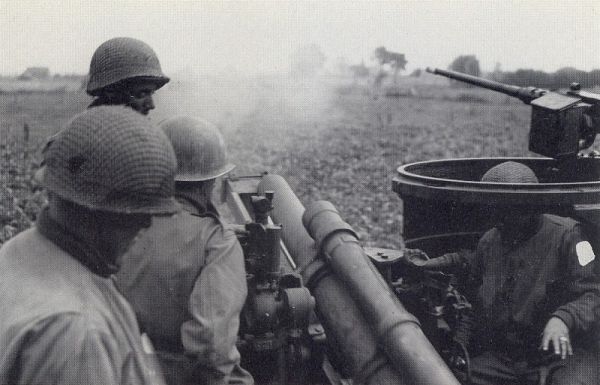 The German 88 mm dual purpose FLAK anti- aircraft and anti- tank gun, also used as regular artillery. Source: Comité Sherman Tank Overloon.
The German 88 mm dual purpose FLAK anti- aircraft and anti- tank gun, also used as regular artillery. Source: Comité Sherman Tank Overloon.7 October - 3 December1944
The British take over: Operation Aintree
The British XXX Corps took over the front line from October, 7th and prepared for a new attack. The Third Infantry Division was put in place and was reinforced with the 6th Armoured Brigade, six artillery regiments, four companies of engineers and two squadrons of mine sweeping flail tanks. On October,10th the plans were ready and the attack was planned for the next day but was postponed due to extremely bad weather to October,12th, 1944. The Germans had also had time to replace with fresh troops.
On October,12th the shelling of Overloon and surroundings began at 11:00 hrs. Heavy and medium artillery, in all 92 pieces, opened fire. Half an hour later, 216 25 pounder field guns joined in the high explosive din. At 12:00 hrs. the creeping barrage began, designed to protect the attacking British infantry. Every five minutes the barrage would move 100 metres. Three battalions charged, one west of Overloon, one at Overloon itself and one east of the village. Despite the intensity of the shelling of a 100,000 shells fired at the German positions not all mine fields were cleared. In the woods German snipers had tied themselves to trees so that if wounded they wouldn’t fall out of the trees and could continue fighting. They also fired at fleeing German soldiers.
Machine guns, rifles, mortar shells and moaning minnies took a heavy toll from the British infantry. Riegel antitank mines blew in bottom plates of tanks and antipersonnel mines ripped of limbs. Not many prisoners were taken. When ammunition ran out the fighting continued with cold steel. Because of the mud many Churchill tanks bogged down.
Overloon was finally taken on October,14th, 1944. Bombers dropped white phosphorous bombs to subdue the last German pocket of resistance in the church. They refused to surrender and were killed to the last man. Overloon or what was left of it was finally liberated.
Second phase of Operation Aintree
It would take until October,19th, 1944 before Venray was liberated. Then the advance stopped. The troops were needed elsewhere. Venray by then was heavily damaged. Hundreds of civilians were killed. Bombing from the air, artillery from both sides and the subsequent fighting on the ground were responsible for this. The church tower of St-Petrus Banden that had served the German artillery observers well during the difficult crossing of the Loobeek was blown up by a Sprengkommando or demolition squad together with all higher structures in the vicinity. Hundreds of British soldiers lost their lives or limbs around the Loobeek, a rivulet that was only crossed on October, 16th, 1944.Since the fighting the rivulet was also called " blood stream." The entire area had been mined by German engineers, the Loobeek was dammed and the abundant rain contributed to the difficulties the British infantry faced. Oberst Laytved-Hardegg, Kommandeur of 21. parachute regiment, commented in 1984:
"It was clear to the responsible corps leaders that my regiment would have a hard time when the British would attack. Thus something happened which on itself is not very regular in war. Engineers placed mines without mapping them, even in the Loobeek itself. The rivulet was dammed so that the entire meadow around it was inundated with 30 cm of water. Obviously that was not easily passed."
Besides this the Germans expected the attack and had good observation of the terrain through the afore mentioned church tower in Venray. Although heavily shelled and strafed by Typhoon fighter bombers armed with 20 mm cannon and 60 pound rockets it exacted a heavy toll from the attacking British infantry. Poor bloody infantry was very true. The mines and shells took their terrible toll. A Dutch volunteer, Wim Baljet, who served with the Royal Army Ordnance Corps or RAOC with the 3rd Infantry Division said that:
"A thousand men came back from the attack. Without arms, without legs, without eyes."
Still the war wasn’t over in the Brückenkopf Venlo. A German counter attack from October 27th-29th near Meijel once again disrupted Allied planning. The attack was repulsed, among others, by the US 7th Armored Division. Once again the danger of the bridge head west of the Meuse was proven.
The British attacked once more on November,14th,1944. The Germans defended tenaciously but were finally pushed in a small bridge head at Blerick (Venlo’s west bank suburb). On December, 3rd, 1944 at 16:00 hour, Blerick was taken.
Although the fighting near Overloon and Venray was labelled to be amongst the fiercest fighting in the entire European Theatre of Operations the battle was more or less forgotten. It was called "The second Caen" by the troops of the 3rd Infantry Division and the 11th Armoured Division. These divisions had slugged it out for months with the Germans in Normandy. In the Netherlands, after Arnhem, there were no spectacular airborne operations or successful armoured manoeuvres. Mud , heavy losses and small gains are better quickly forgotten. The battles for the Hürtgenwald met with a similar fate.
In Overloon the reaction was different. Already in 1946 first steps were taken to open a museum there. To this very day this museum houses tanks and other armaments retrieved from the former battle field.
Definitielijst
- bridge head
- Area of conquered territory on other side of a (natural) obstacle from which the attacker can continue his advance.
- Brigade
- Consisted mostly of two or more regiments. Could operate independently or as part of a division. Sometimes they were part of a corps instead of a division. In theory a brigade consisted of 5,000 to 7,000 men.
- cannon
- Also known as gun. Often used to indicate different types of artillery.
- Infantry
- Foot soldiers of a given army.
- mine
- An object filled with explosives, equipped with detonator which is activated by either remote control or by colliding with the targeted object. Mines are intended to destroy of damage vehicles, aircrafts or vessels, or to injure, kill or otherwise putting staff out of action. It is also possible to deny enemy access of a specific area by laying mines.
- mortar
- Canon that is able to fire its grenades, in a very curved trajectory at short range.
- regiment
- Part of a division. A division divided into a number of regiments. In the army traditionally the name of the major organised unit of one type of weapon.
- resistance
- Resistance against the enemy. Often also with armed resources.
- shelling
- Indication for shooting targets with grenades. Both from artillery and armoured artillery.
Images
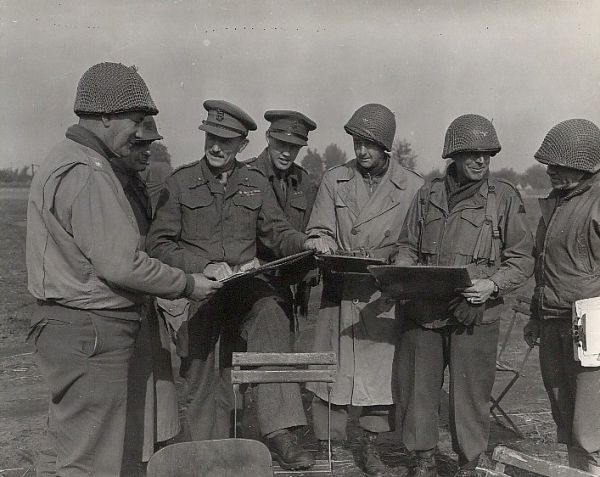 The Americans hand over command to the British on October, 7th,1944. Source: Comité Sherman Tank Overloon.
The Americans hand over command to the British on October, 7th,1944. Source: Comité Sherman Tank Overloon. The British Third Division and supporting Sherman tanks on their way to Overloon. Source: Comité Sherman Tank Overloon.
The British Third Division and supporting Sherman tanks on their way to Overloon. Source: Comité Sherman Tank Overloon.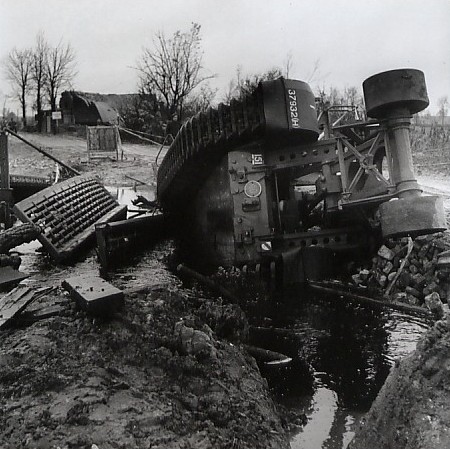 Turned over bridge laying AVRE tank in the Loobeek. Source: Comité Sherman Tank Overloon.
Turned over bridge laying AVRE tank in the Loobeek. Source: Comité Sherman Tank Overloon. British troops liberate Venray. Source: Comité Sherman Tank Overloon.
British troops liberate Venray. Source: Comité Sherman Tank Overloon.End
Losses
Most estimates provided for the US 7th Armored Division : 220 killed in action and 232 wounded and missing in action; a total of 452 casualties. Part of the KIA was reburied at the US war cemetery of Margraten after the war. Part of those killed were in the 35 tanks, mainly M4 Sherman, and the 43 other vehicles lost. Two airplanes were shot down. One of these was a P-47D Thunderbolt that was downed over Overloon on October 2nd, 1944 and that crashed at the Zandstraat 8. J. Hodgson, Royal Army Medical Corps (RAMC), 9th Field Ambulance, reported:
" There was the ruins of a crashed aircraft which turned out to be a Thunderbolt. My colleague was inspecting the wreckage and he called me over after finding something that he couldn’t identify. I came over and knelt down and we were very surprised to discover that this was the body of a man. Badly burned and he looked exactly like a piece of wood."
They had found the remains of First Lieutenant W.R. Grounds who was shot down over Overloon ten days before.
The British lost 1,426 casualties, among whom 753 dead and missing. Third Infantry Division lost 400 dead and 11th Armoured Division lost 273 killed. At Overloon war cemetery 281 of them rest. Approximately 20 tanks and an airplane were lost beyond repair.
German losses are estimated at 600. Most of them were reburied after the war on the military cemetery of nearby Ysselsteyn . Precise numbers are hard to come by. Hundreds of them must have been captured. On October,12th, the first day of the British assault, 147 were taken prisoner.
107.Panzerbrigade had on October, 31st 8 Mark IV and 11 Panther Mark V tanks. This implies a loss of 8 Panthers in October. Parachute battalion Paul lost, between 2nd and 14th of October, 402 men. 81 killed, 80 wounded and 241 missing, from whom 102 were taken prisoner on October 12th.
Not everyone who surrendered was spared. Corporal T. Hall from the East Yorkshire regiment reported in 1984:
"A German who had hidden in a furrow stood up, threw away his rifle and said:’Kaputt, fini." Our officer was a Canadian and he pushed his revolver in his back and said: "Run, you bastard, run." After we found some shelter from the enemy machine gun that we were ordered to silence our officer told me to kill him. I was corporal and I ordered Payne, who was private, to shoot him. The prisoner was shot and fell to the ground but wasn’t dead yet. He pointed to his head and Payne shot again."
The losses of the Dutch civilian population are also difficult to determine precisely. A number of 300 dead is given. Overloon and the rest of the area was evacuated but some people stayed behind and hid in their cellars. The population of Venray rose from 17,000 to 25,000 in a matter of days. There were two mental institutions in Venray that came under fire for weeks. The mentally insane and the staff had to hide in the basements . Unimaginable things happened there including rape by frenzied patients. On October, 12th, 36 US B-26 Marauder medium bombers bombed Venray and killed 32 civilians. The town was heavily shelled by both sides. On October, 13th, a number of 15,000 shells was fired in three hours. The tower of St.-Petrus Banden, after being marked with red smoke shells, received 284 60 pound rockets from Typhoon fighter bombers. Before leaving the Wehrmacht blew it up. A week after the liberation the civilian population was evacuated on instruction from the British troops.
Shell shock
Neurasthenia or shell shock occurred frequently. Above mentioned corporal Hall tells, 40 years after, with a still grief ridden and distorted face:
"Private Payne was 19 years old. He always hang out with an older soldier of 28 years old, Dawson. They were really a fighting team. On a morning there was a lot of shelling from the Siegfried line beyond. Dawson went out on a search for fat to bake some fried potatoes. He didn’t return. Later we went on patrol and we found him without his head. When Payne saw his friend he literally collapsed. He started crying real big tears and emotionally he was finished. He couldn’t hold a limb still. All his webbing and all of his things fell off his arms. He was spent, absolutely finished."Maybe Payne saw a connection between the prisoner he had murdered and his friend being killed. In a way all three of them lost their heads.
Conclusion
The bloody fighting at Overloon, the Molenbeek , Venray and surrounding villages and woods can be seen as a defensive success for the Germans. Terrain was slowly given up and heavy casualties were inflicted. The Germans fought with their backs against the Meuse and they were told that the bridges were blown up. The Durchhaltepropaganda, the Nazi propaganda certainly played a role. Many German soldiers, even at this stage of the war, believed that they still could win or gain a favourable peace. Faith in their new weapons played a role. Terror behind the fronts by remorseless court martials were a factor. Feldwebel (sergeant-major) H.Weber from 21. parachute regiment said forty years after:
" I still cannot tell you where we got our morale from. I really cannot explain why we fought so tenaciously. Sure, we were told that we couldn’t fall back because behind us was the Meuse and the bridges had been blown up."
Hauptmann(captain) Paul, commander in a battalion of the same regiment, commented, in 1984,
"I had to fulfil my duty, I had to carry out my orders. Otherwise and this must be crystal clear to you, I would have been put against the wall and executed. No single doubt about that. Already many men had undergone the same fate and were hung from a rope in Germany."
In the same interview he said that friend and foe had given their utmost and had behaved gallantly.
Definitielijst
- Infantry
- Foot soldiers of a given army.
- KIA
- Killed in Action. Died due to hostile attack.
- machine gun
- Machine gun, an automatic heavy quick firearm.
- Nazi
- Abbreviation of a national socialist.
- propaganda
- Often misleading information used to gain support among supporters or to gain support. Often used to accomplish ideas and political goals.
- regiment
- Part of a division. A division divided into a number of regiments. In the army traditionally the name of the major organised unit of one type of weapon.
- shelling
- Indication for shooting targets with grenades. Both from artillery and armoured artillery.
- Wehrmacht
- German armed military forces, divided in ground forces, air force and navy.
Images
 Abandoned military equipment on the battle field of Overloon, October,13th, 1944 Source: Beeldbank WO 2.
Abandoned military equipment on the battle field of Overloon, October,13th, 1944 Source: Beeldbank WO 2.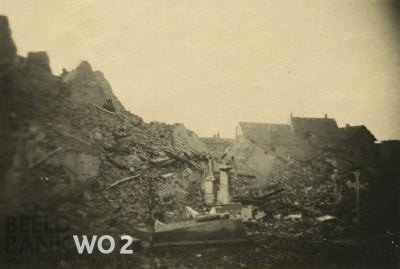 The devastated church at Overloon. Source: Beeldbank WO2.
The devastated church at Overloon. Source: Beeldbank WO2.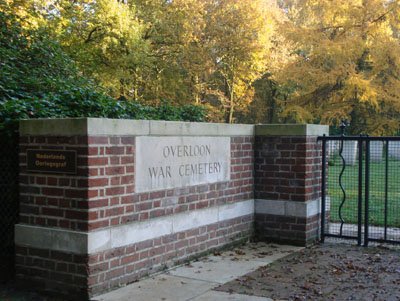 Entrance of the Commonwealth War Cemetery at Overloon. Source: Ewoud van Eig.
Entrance of the Commonwealth War Cemetery at Overloon. Source: Ewoud van Eig.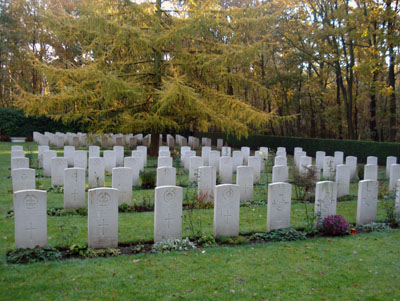 Part of the 280 graves at CWC Overloon. Source: Ewoud van Eig.
Part of the 280 graves at CWC Overloon. Source: Ewoud van Eig.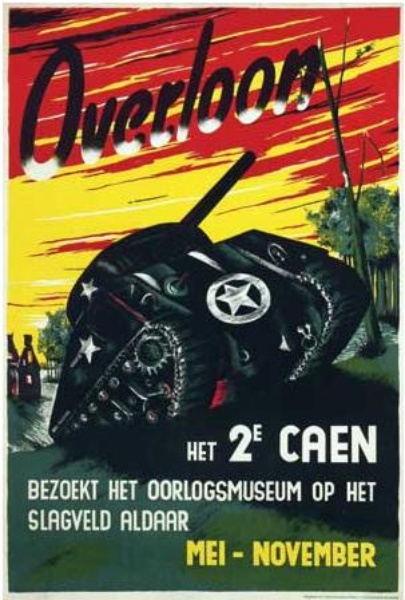 Poster from the initial years of the Overloon War Museum. Source: Oorlogsmuseum Overloon.
Poster from the initial years of the Overloon War Museum. Source: Oorlogsmuseum Overloon.Information
- Article by:
- Peter ter Haar
- Published on:
- 12-02-2014
- Last edit on:
- 30-09-2024
- Feedback?
- Send it!
Related sights
Related books
Sources
- Bericht van de Tweede Wereldoorlog 5, De Geïllustreerde pers, Amsterdam, 1971.
- LAK, M., Geen boompje is meer heel, Aspekt, Soesterberg, 2007.
- REUTH, R.G., Joseph Goebbels Tagebücher 1924-1945, Piper, München, 2008.
- DVD: De vergeten slag, bevrijding van Overloon en Venray in 1944, Venray, 1989.
- Axis History Factbook
- Comité Shermantank Overloon
- Geschiedenis24 / Andere Tijden: Vergeten slag om Overloon
- Lexikon der Wehrmacht
- Lucky Seventh
- Panzerworld
- Wikipedia: Slag om Overloon
